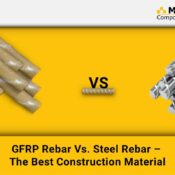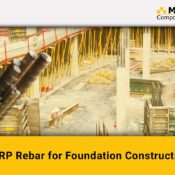GFRP Rebar for Base slab and industrial floor Construction
Base Slab
Base slabs are a fundamental part of many concrete structure projects. They provide the essential support and reinforcement for the concrete and keep the structure together. Base slabs can be made from various materials. Many materials are available such as CFRP, FRP, Steel reinforcement bars, GFRP Rebar, etc. but the most popular choices are concrete and GFRP Rebar. Concrete is the most common material used in foundation construction and is the most popular choice for base slabs because of its durability and resistance to weathering. GFRP Rebar is stronger, lighter, durable, cost-effective and corrosion resistant material. A slab base is an essential part of your deck building strategy. Not only does it provide stability, but it can also add an extra layer of defence to your structure. Choosing the correct slab base ensures that your structure can stand up to even the most punishing cards.
Why is a Base Slab necessary?
Base slabs adds stability and strength to a wall and are necessary when using a frame construction. Without base slabs, a wall may be unstable and potentially unsafe. It provides the necessary support for the finished product. A poorly designed base slab can lead to significant problems down the road, such as uneven sections that cause the finished structure to sag or cracks that allow water and other contaminants to seep into the concrete. In addition, a poorly designed base slab can cause instability in the finished structure. It provides the foundation for the wall and roof, without it, the entire structure would be at risk of collapseConstruction of slab
- Prefabricated slabs:- Prefabricated slabs are built in the factory and transported to the working site. It is ready to use and placed between GFRP Rebar or concrete beams. It can be pre-stressed, post-stress or unstressed. The slab must be built in perfect dimensions.
- Onsite:- As the name suggests, these slabs are built on a working site using the framework. It is a type of boxing into which the wet concrete is poured. If the slab is to be reinforced, the GFRP rebars are positioned within the form work before the concrete is poured in.
Industrial Floor
The industrial floor was previously coated with epoxy to protect against abrasion and chemical attacks. However, the coating began to fail and caused the floor to become slick and uneven. Many industrial businesses such as warehouses, factories and other commercial facilities have large areas of concrete flooring. These are usually either poured in place or precast. Once the concrete is dry, it is often ground smooth. Once this process is completed, a sealer is applied to help protect the floor and give it a long-lasting finish. The industrial floor of a non-food manufacturing facility is where the primary manufacturing process occurs. The base is usually made of concrete and must be level, clean, and smooth. There are many potential hazards on an industrial floor, so it must be well-maintained. A school district’s summer program runs industrial and commercial floors. The industrial floor is responsible for the machines and the work on the machines. The commercial floor is responsible for the people who use the machines. The two floors are in different parts of the country and have different climates.Why is an Industrial Floor necessary?
Flooring is necessary for industrial and commercial settings for a few reasons:- It can help to keep workers safe by providing a steady surface on which they can stand.
- Floors can make it easier to clean up accidents.
- Floors can help to create an overall more organized and efficient workspace.
Glass Fiber Reinforced Polymer Rebar
 GFRP (Glass Fiber Reinforced Polymer) rebar, commonly referred to as Fiberglass reinforcement, is a high tensile strength alternative to steel reinforcement. GFRP Rebar is a stronger, lighter, cost-effective and corrosion-resistant material. Water present in septic tanks that damage the structure, GFRP Rebar is the solution of this problem. GFRP Rebar is a corrosion-resistant material.
GFRP (Glass Fiber Reinforced Polymer) rebar, commonly referred to as Fiberglass reinforcement, is a high tensile strength alternative to steel reinforcement. GFRP Rebar is a stronger, lighter, cost-effective and corrosion-resistant material. Water present in septic tanks that damage the structure, GFRP Rebar is the solution of this problem. GFRP Rebar is a corrosion-resistant material.
Advantages of GFRP Rebar
- Stronger:- The foundation must be strong to handle the stress. GFRP Rebar is two times stronger than steel reinforcement bars.
- Lighter:- GFRP Rebar is ¼ lighter than the steel reinforcement bars.
- Cost-effective:- GFRP Rebar is a cost-effective material. You can get the best quality at a low cost for Construction.
- Water-compatibility:- GFRP bars are water compatible. GFRP bars corrosion-resistant. It is one of the main advantages of bridge construction. We can use this rebar for a wide range of bridges.
- Durability:- GFRP bars are very durable. GFRP Rebar provides the long life span of the Construction, building, and bridge Construction.
- Easy transportation:- The ride of GFRP Rebar is effortless. You can bend this rebar easily. So it makes it quick to load rebars on the vehicle.
- High temperature:- GFRP bars can handle the high-temperature stress. You can use this material in bridges, tunnels, highways, nuclear stations, and power stations.
MRG Composite Rebar
MRG Composite Rebar is a leading GFRP Rebar manufacturers in india and supplies worldwide. Our rebars are stronger, lighter, and cost-effective than steel reinforcement bars. We are best known for our GFRP rebar. Our GFRP rebar is the perfect choice for bridge construction. MRG Composite Rebar can provide high-quality industrial flooring. One of our specialities is in flooring for industrial and commercial clients. Our floors can help you keep your business look best. We offer a variety of flooring options to choose from.Conclusion
Many materials are available in the market, like CFRP, FRP, steel reinforcement bars, TMT, and GFRP Rebar. GFRP bars are the best material for the construction project. GFRP Rebar is a corrosion-ressistant material so GFRP Rebar is the best option for septic tank construction.All Categories
Recent Posts
GFRP Rebar vs. Steel Rebar: Strength, Durability & Benefits
GFRP Rebar for Foundation Construction
MON-SAT 8:00-9:00
+91 69 863 6420




